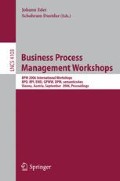Abstract
Generic reference models are based on the assumption of similarity between enterprises – either cross industrial or within a given sector. The research describes a validated reference metamodel, based on an empirical study of enterprises from various industrial sectors. Drawing on the metamodel, we suggest a methodology and tools for the design and generation of individualized business process models.
Access this chapter
Tax calculation will be finalised at checkout
Purchases are for personal use only
Preview
Unable to display preview. Download preview PDF.
References
Davenport, T.: Process Innovation: Reengineering Work through Information Technology. Harvard Business Press, Boston (1993)
Hatten, K.J., Rosenthal, S.R.: Managing the Process-Centered Enterprise. Long Range Planning 32(3), 293–310 (1999)
Gulledge, T.R., Simon, G., Sommer, R.A.: Using ARIS to Manage SAP Interoperability. In: Scheer, A.-W., Jost, W., Abolhassan, F., Kirchmer, M. (eds.) Business Process Excellence: ARIS in Practice, pp. 87–108. Springer, Heidelberg (2002)
Oracle. Business Models (OBM) (2004), http://www.oracle.com/consulting/offerings/implementation/methods_tools/
SAP. Business Maps and Solution Composer (2004), http://www.sap.com/solutions/businessmaps/composer/
Wasser, A., Lincoln, M., Karni, R.: Accelerated Enterprise Process Modeling Through a Formalized Functional Typology. In: van der Aalst, W.M.P., Benatallah, B., Casati, F., Curbera, F. (eds.) BPM 2005. LNCS, vol. 3649, pp. 446–451. Springer, Heidelberg (2005)
Wil, M.P., van der Aalst, A., ter Hofstede, H.M.: YAWL: yet another workflow language. Inf. Syst. 30(4), 245–275 (2005)
Fettke, P., Loos, P., Zwicker, J.: Business Process Reference Models - Survey and Classification. In: Bussler, C.J., Haller, A. (eds.) BPM 2005. LNCS, vol. 3812, pp. 469–483. Springer, Heidelberg (2006)
Dellarocas, C., Klein, M.: A Knowledge-Based Approach for Designing Robust Business Processes. In: van der Aalst, W.M.P., Desel, J., Oberweis, A. (eds.) Business Process Management. LNCS, vol. 1806, pp. 50–65. Springer, Heidelberg (2000)
Bernstein, A.: Process Recombination: An Ontology Based Approach for Business Process Re-Design. SAP Design Guild, vol. 7 (October 2003)
Malone, T.W., Crowston, K.G., Herman, G. (eds.): Organizing Business Knowledge: The MIT Process Handbook. MIT Press, Cambridge (2003)
Light, B.: The maintenance implications of the customization of ERP software. J. Software Maintenance: Res. Practice 13, 415–429 (2001)
Intentia. Enterprise Reference Models (2004), http://www.intentia.com/WCW.nsf/pub/tools_index
Lincoln, M., Karni, R.: Generic Business Function Framework for Industrial Enterprises. In: CD Proceedings of 17th ICPR Conference, Blacksburg, VA, USA (October 2003)
EDS. EDS website (2005), www.eds.com
IBM. IBM website (2005), ww1.ibm.com/services/us/bcs/html/bcs_index.html?trac=L1
Accenture. Accenture web-site (2005), www.accenture.com/
Pegasystems. Pegasystems website (2005), www.pegasystems.com
Staffware. Staffware website (2005), www.staffware.com
Filenet. Filenet website (2005), www.filenet.com
SPSS, SPSS User Guide to Software Version 9, SPSS Institute (2006)
Weske, M., van der Aalst, W.M.P., (Eric) Verbeek, H.M.W.: Advances in business process management. Data Knowl. Eng. 50(1), 1–8 (2004)
Recker, J., Rosemann, M., van der Aalst, W.M.P., Mendling, J.: On the Syntax of Reference Model Configuration: Transforming the C-EPC into Lawful EPC Models. BPM Center Report BPM-05-21
Recker, J., Mendling, J., van der Aalst, W.M.P., Rosemann, M.: Model-driven Enterprise Systems Configuration. In: Dubois, E., Pohl, K. (eds.) CAiSE 2006. LNCS, vol. 4001, pp. 369–383. Springer, Heidelberg (2006)
Author information
Authors and Affiliations
Editor information
Editors and Affiliations
Rights and permissions
Copyright information
© 2006 Springer-Verlag Berlin Heidelberg
About this paper
Cite this paper
Wasser, A., Lincoln, M., Karni, R. (2006). ERP Reference Process Models: From Generic to Specific. In: Eder, J., Dustdar, S. (eds) Business Process Management Workshops. BPM 2006. Lecture Notes in Computer Science, vol 4103. Springer, Berlin, Heidelberg. https://doi.org/10.1007/11837862_6
Download citation
DOI: https://doi.org/10.1007/11837862_6
Publisher Name: Springer, Berlin, Heidelberg
Print ISBN: 978-3-540-38444-1
Online ISBN: 978-3-540-38445-8
eBook Packages: Computer ScienceComputer Science (R0)

